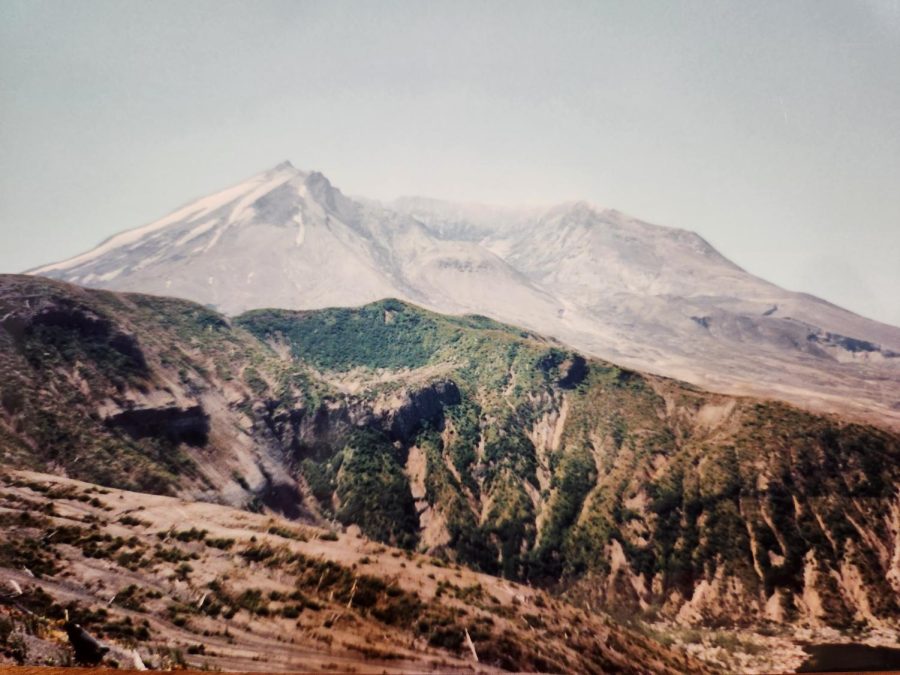Mount St Helens: Our Next Door Neighbor
June 15, 2023
On May 18, 1980, the deadliest volcanic eruption in Washington state took place: Mount St Helens. The disaster killed fifty-seven people and devastated two hundred square miles of wilderness. Native Americans called Mount St Helens ‘Louwala-Clough,’ which translates to ‘the smoking mountain.’
Mount St Helens has had an active history since the very beginning of its formation. Around 275 thousand years ago, Mount St Helens began its eruption stage, now known as the Ape Canyon Stage. During the Ape Canyon Stage, “lava domes erupted just west of the present volcano in two distinct periods—one from 275 to 250 thousand years ago (ka) and a second from 160 to 35 ka.” (USGS). Ash from this period has been discovered as far east as central Washington, showing that the 1980 eruption wasn’t the first one of such explosiveness. The next stage of the mountain, called the Cougar Stage, was from 28 to 18 thousand years ago. According to the US Geological Service, “The Cougar debris avalanche was the most devastating event of the Cougar Stage, and was probably larger than the huge debris avalanche that triggered Mount St. Helens’ 1980 eruption.” The avalanche started near Butte Camp and left a 900-foot thick deposit, and temporarily dammed the Lewis River. Erosion of the dam caused flooding downstream as far as the Columbia River and filled the lower Lewis River Valley with volcanic debris at least 200 feet thick. The second to last stage before the catatonic eruption in 1980 was the Swift Creek Stage, lasting from 16 to 12.8 thousand years ago. This period was relatively short-lived and quiet. The only major activity during this period was the formation of dacite domes on and around the volcano. The Spirit Lake Stage started 3.9 thousand years ago and is still continuing. This period has been filled with intermittent eruptions.
Two months prior to the infamous eruption, earthquakes began to shake the ground repeatedly, “and on March 27 a minor eruption occurred, and Mount St. Helens began emitting steam and ash through its crater and vents.” (History). One month later, people living close to the volcano began to notice changes in the mountain’s appearance. A bulge was forming on the north side of the volcano, moving upwards and outwards at a rate of 6 feet per day. “On May 18, 1980, a magnitude-5+ earthquake was accompanied by a debris avalanche, which in turn unloaded the confining pressure at the top of the volcano by removing the crypto dome,” following this release of pressure, the north side of the mountain sloughed away in a huge landslide (USGS). The shockwave from the blast leveled nearly all vegetation in a 12-mile radius. Mudflows, pyroclastic flows, and floods added to the destruction, destroying roads, bridges, parks, and thousands more acres of forest. Simultaneous with the avalanche, gas, and ash formed a mushrooming column over the volcano over 12 miles high. By the time the eruption stopped, the mountain was 1,700 feet shorter than before.
In 2004 Mount St Helens reawakened. In late September, several shallow earthquakes shook the ground and only grew in strength and frequency over the next few months. In October, the volcano erupted once again but only sent up plumes of volcanic ash and gases. Spines of hardened lava began to push through the crater floor later that year. In 2005 there were two unexpected explosive eruptions that disturbed geologists’ monitoring equipment. Neither eruption had strong adverse reactions to the climate. Geologists warn that Mount St Helens will erupt again but do not expect a repeat of the 1980 catastrophe anytime soon.
Sources
“1980 Cataclysmic Eruption.” 1980 Cataclysmic Eruption | U.S. Geological Survey, www.usgs.gov/volcanoes/mount-st.-helens/1980-cataclysmic-eruption#:~:text=On%20March%2016%2C%201980%2C%20the,eruption%20in%20over%20100%20years.
History.com Editors. “Mount St. Helens Erupts.” History.com, A&E Television Networks, www.history.com/this-day-in-history/mount-st-helens-erupts-2.
“Mount St. Helens.” Mount St. Helens | U.S. Geological Survey, www.usgs.gov/volcanoes/mount-st.-helens.













